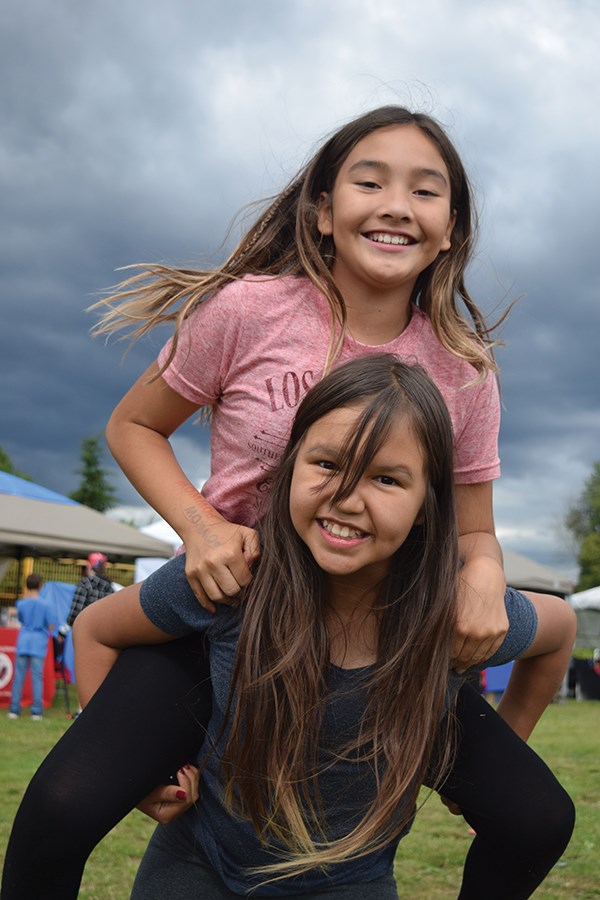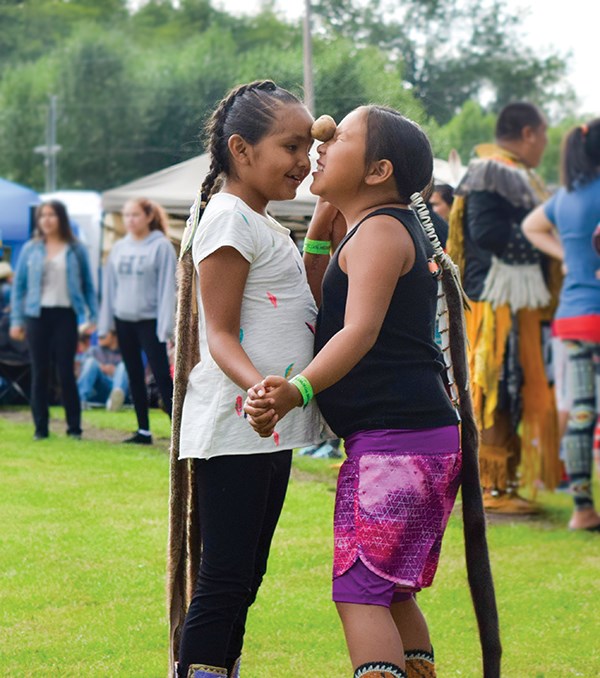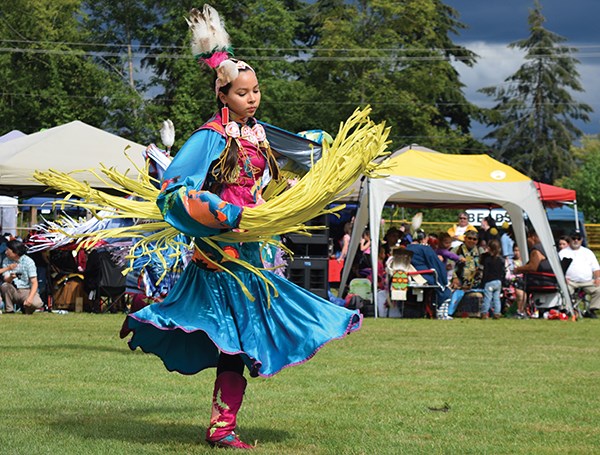Two girls and a boy sit sharing lunch on the grass in the vendor’s area of the 28th Annual Squamish Nation Youth Powwow. Kaden Isaac, 13, occasionally taps his feet to the infectious drumbeat accompanying the Men’s Golden Age dance competition taking place beyond the bleachers a few metres away.
His sister Kiana and her friend Keisha Wallace, both 10, eat while giggling over something on a computer tablet beside him.
Their favourite powwow food is Indian tacos, Keisha says, which is ground beef, chili sauce, lettuce and cheese inside a bannock wrap.
Taking a break from watching, Kaden said his favourite part of the powwow is the dancing and the elaborate, colourful regalia. He adds he wishes more non-native people knew the importance of the unique dances and did not take them lightly.
“Not to make fun of people who dance different than other people,” he said. “It is part of traditions, it is not funny.”
The annual three-day powwow took over Capilano Reserve Park at Chief Joe Mathias Centre in West Vancouver from July 8 to 10, as First Nations from around North America travelled to the area to take part.
While mostly serious, some of the powwow events are traditional fun, such as the Potato Dance Special held Saturday afternoon, which welcomed natives and non-natives alike.
Participants pair up in a large circle and each couple balances a potato between their foreheads. As master of ceremonies at the Squamish powwow, the witty Nelson Leon directs the couples to do tasks such as bending down to touch the ground while keeping the potato in place. If the potato falls, the couple is eliminated. The task gets harder and harder until the last couples remaining have to jump without dropping the potato. Last couple standing wins.
Passing on First Nation traditions is a large part of the 28th Annual Squamish Nation, say Youth Powwow organizers.
“To our youth, this is how we show our love and support to you,” coordinator Gloria Nahanee wrote in the event’s program.
Nahanee is largely credited with reviving the Squamish Nation’s powwow in the late 1980s after many years. Canadian and American governments banned powwows and other First Nation cultural celebrations through the late 1800s and early 1900s.
“Our ancestors did them from 1947 to 1958 and then they were already elderly, in their 70s or 80s,” said Nahanee, explaining why the powwows at Capilano stopped for many years starting in the 1960s.
“I remember my grandmother was cooking and I would be running back and forth and playing. And then as our elders passed away it just stopped,” she said.
Nahanee started her daughters dancing in 1986, and the family began to travel to powwows.
“A few powwow people, when we travelled, they would say, ‘Oh, I remember going to Squamish, Capilano, you should start it up again.’… So 28 years later, here we are.”
Many of the original organizers of the revived event now have grandchildren who come, Nahanee added.

Fellow organizer Keith Nahanee said he is carrying on in his father’s footsteps.
“We are taught to be involved, caring for the community,” he said, as he fed electrical cord up to a light inside one of the dozen canopy tents on the powwow grounds.
“When my dad was a young man and we were kids… we would go up to the old council hall and he would play records and teach dancing, just for the kids to have something to do. He knew that was the way to keep them from getting lost, so that is what we do here.”
Several parents and grandparents at the powwow spoke to The Squamish Chief of the event being on “the red road,” or the healthy and purposeful path as opposed to the “black road,” that being one of bad choices.
The powwow welcomes those on either road, Nahanee said.
“When they are here we always say we know where our kids are and what they are doing,” he added.
For almost a decade during the 1980s fellow organizer Jan Baker took her children to out-of-town powwows on weekends.
“To show them that there’s life outside this reserve and that people can have fun without alcohol, and plus we travelled to a lot of other places, and other reserves,” she said. “It was a blast.”
One of the reasons for starting the powwow on the Capilano reserve was to expose those children who couldn’t travel far to the values of the powwow, Baker said, adding, “to see the powwow, to hear the teachings and see the dancing.”
Lena May Nahinu gasped with joy as she watched her 10-year-old daughter Mabel Leona Alana dance in the junior girls Fancy category on Friday evening.
“I am so proud of my daughter,” she said, adding Mabel had been practising her dance daily in the lead-up to the powwow, all while training every day for soccer.
“She loves her culture,” Nahinu said.
Mabel placed third in her category but was so excited to dance, she didn’t much mind where she placed, according to her mom.
“She is in it for the dancing,” Nahinu said.
The enthusiasm of First Nations youth for dance and powwows thrills veteran traditional dancer Arnie Mountain Chief, who competed in the Men’s Golden Age division over the weekend.
His five children and eight grandchildren all dance. “When they are in here, we know where they are,” he said of the many youth taking in the powwow, again referencing the red road of the powwow. “It is all one big family, everybody knows everybody else.”
Mountain Chief explained the dances and their judging are sophisticated.
“The judges judge you on how you interpret the song – some people are smoother than others – and some seem like they are right into the music, like a ballet dancer,” he said.
Judges also take into consideration the dancer’s regalia, including the condition of the feathers.
“That is a big part of being a traditional dancer especially. We carry a lot of eagle feathers, and those are the most sacred bird to us.”
A dancer never perfects his dance, Mountain Chief added.
“It is an ongoing thing, we continue to learn."





